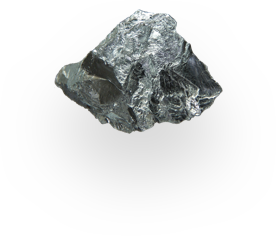Indium
Properties
Indium is a silvery-white soft metal. Its crystal structure is tetragonal face-centered with the following parameters: a=0.4583pm, c=0.4936pm. The density of indium is 7310 kg/m3. Indium is malleable, its melting point is 156.78°С, boiling point is 2024°С; specific heat at 0-150°С 234.461 J/kg•К, Young ‘s modulus – 11GPa, Brinell hardness – 9MPa. The oxidation degree is +3, occasionally +1 and +2. Indium is stable in air at room temperature; slowly reacts with HCl, Н2SO4 and others, quickly with HNO3; does not enter into reaction with alkalies. At room temperature reacts with Cl2 and Br2, upon heating – with I2 and О2. Indium is a typical trace element, its Clark in the earth’s crust is 2.5•10-5%. Its native minerals are very rare (native indium, indium hydroxide; other trisulphides) and are of no practical importance. In its geochemical properties indium is very similar to Fe, Zn and Sn. Major indium bearing minerals (normal indium, %): sphalerite (0.0049), chalcopyrite (0.0012), tinore (0.0024), galena (0.0004). It is concentrated mostly in high temperature hydrothermal polymetallic ores, particularly containing both zinc (copper) and stannic (up to 0.1-0.5% in sphalerite, 0.05-0.1% in chalcopyrite), in colloform SnO2 (up to 1%). Indium enrichment is characteristic of Passific ore belt deposits. World proven indium reserves (excluding Second World countries) are estimated in 1590 tons, non-commercial reserves make about 1900 tons.
Production and application
Indium is produced as a by-product when processing nonferrous metal ores; its main source metals are waelz-oxides of zinc production, dust and slag of lead production, fumes of stannum refining by vacuum heat. Indium is leached out of waelz-oxide with Н2SO4 solution and after that it is extracted and purified by cementation or electrolysis.
Application: aviation and automotive industry (anti-corrosion сoatings, bearing lubricants, untarnishable mirrors and reflectors with high reflection capacity, semiconductor equipment, radiotechnology and electronics (production of indium arsenide, antimonide and phosphide of different semiconducting properties; additives to Ge and Si; production of diode, triodes and rectifiers), atomic energy (indium containing reactors rods), instrument engineering (low-temperature solder alloys, etc.), chemical engineering (alloys, resistant to alkaline corrosion), glass industry and etc. The world annual production volume of purified indium (excluding Second World countries) is 40-50 tons. Primary production countries — the USA, Canada, Japan, Peru.



